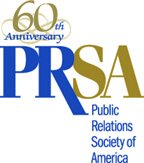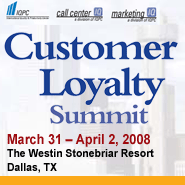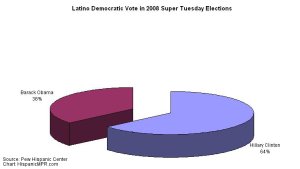Posted by Elena del Valle on March 13, 2008

Siesta Tees t-shirt
Photos: Siesta Tees
Greg Sanchez started his company by adding Latino beliefs and Spanglish phrases on t-shirts as a hobby a year ago. Now Siesta Tees, a small Hispanic owned business based in San Antonio, Texas is selling 50 products with Latino themed designs through its online portal. In addition to t-shirts for adults and children, Siesta Tees sells infant clothes, mugs, aprons and caps divided into four lines: home, family, youth and Ojo.
For the sayings Sanchez mixes Latino folklore, beliefs and sayings passed on from grandparents to create a product line meant to fill a void in the main stream Latino market and meet the company motto, creating laughs one tee at a time. Sanchez’ inspiration for the sayings comes from watching his family and friends in their daily lives. Siesta Tees phrases include “Stop the violence – hit a piñata,” “I love abuela,” “I think the chupacabra is under my bed” and “Don’t make me use my chancla.”

Siesta Tees t-shirt
“Latino Family Dynamics” audio recording


Brenda Hurley and Liria Barbosa
Discuss
- Latino purchasing habits and products they favor
- Latino family characteristics
- Latinos and extended families
- Division of duties, responsibilities within the family
- Who is the decision maker in the Latino family
- Who is the information provider in the Latino family
Click here to find out about Latino purchasing habits and “Latino Family Dynamics”
“Our first t-shirt was made just for fun, it was our Touch me before you give me Ojo design. We began getting sales from our online store without any paid advertising and no paid marketing. All our marketing was very basic: forums, blogs and word of mouth,” said Sanchez, owner and founder of Siesta Tees. “Creating a funny, hip, cute Hispanic themed clothing line was a no brainer. We focused strictly on the main stream Latino market. After, much research we found that the Latino population is the fastest growing, but the main stream Latino community was still under served.”
He relies on a fulfillment company to manufacture and ship the products directly to his customers. Prices range from $12.99, for an infant bodysuit, to $19.99 for a ringer t-shirt.
According to Sanchez, the online shop offers a 30-day return guarantee and a toll free customer service line. He hopes local stores will soon carry his products, allowing customers to purchase them at retail outlets and online.
Reach Hispanics online today with
“Marketing to Hispanics Online” audio recording
Identifying and characterizing the booming Hispanic online market



Joel Bary, Alex Carvallo and Matias Perel
Find out about
• The 16 million Latino online users
• Latino online users by gender
• What they do online
• Their language preferences
• How to reach Hispanic urban youth online
• What affects their online behavior
• What influences their purchases
Click here for information about “Marketing to Hispanics Online”
Posted by Elena del Valle on March 12, 2008

Jorge Restrepo, CEO and principal researcher of EurekaFacts
Photo: EurekaFacts
A Maryland company, EurekaFacts, recently released a Hispanic demographic segmentation system developed from a sample of 150,000 Hispanic households they consider representative of the 12 million Latino households nationwide. With Seg-men-tos, the new system, the company promises future clients detailed Hispanic consumer market information. EurekaFacts representatives plan to update the database every year.
The new system features nine segment groups; each segment ranges between two and five million people with similar characteristics such as language preferences, affluence, geographic region, cultural heritage and life stage. Seg-men-tos is modeled after segment clustering systems such as Claritas’ Prizm and ESRI’s Community Tapestry.
“By knowing how to identify the distinct demographic attributes of Latinos, market by market and zip code by zip code, marketers and strategic communicators can now target the right audiences and craft their message to the fragmented Hispanic market in the U.S.,” said Jorge Restrepo, CEO and principal researcher of EurekaFacts. “Seg-men-tosSM offers a complete profile of most Hispanic households, giving organizations the data they need to reach defined sub groups and improve or initiate customer relationships.”
Listen to Cesar Melgoza discuss
“Changing Latino Landscape” audio recording

Presenter Cesar Melgoza, managing director, Latin Force Group
Find out about
• How demographic, social, political and economic factors affect Latinos
• Number of Hispanics in U.S.
• Hispanics as a percent of the mainstream population
• Number of Puerto Ricans in Puerto Rico
• Hispanics, including Puerto Rico, as a percent of U.S. mainstream
• Number of Asians and African Americans
• Estimated size of Hispanic market by 2012
• Percentage growth of new Hispanics per year
• Number of counties where Latinos are majority
• Areas of significant Latino growth
• Area of U.S. with a 950 percent Latino growth
• Role of acculturation
• Hispanicity segmentation
Click here for information on the Changing Latino Landscape
Promotional materials indicate the Seg-men-tos Hispanic demographic data set can be loaded to a workbook. The system also includes customer profiling services, direct marketing lists, market reports and custom surveys. Pricing for the new system single user starts at $895 for an indefinite license.
It provides reports, charts and maps using a who, what, where and how sequence to analyze behavioral profiles, lifestyle correlations, market potential, target concentration and media preferences. ESRI, a provider of geographic and demographic information systems, will supply population projections to EurekaFacts.
EurekaFacts LLC is a market research and analysis firm that specializes in geo-demographic profiling and customer segmentation with an understanding of the Hispanic market. The private-held company was established in 2003 in Rockville, Maryland.
“Segmentation by Level of Acculturation” audio recording

Presenter Miguel Gomez Winebrenner
Discusses
- Assimilation versus acculturation
- Factors that affect Latino acculturation
- How to know if someone is acculturated
- Number of years necessary for acculturation
- Effects of immigration debate on acculturation
- Three main ways of segmenting Latinos
Click here for details about “Segmentation by Level of Acculturation”
Posted by Elena del Valle on March 11, 2008




Jeffrey Julin, APR, chair, PRSA and Elena del Valle, MBA
New York and Boca Raton, Fla. March 11, 2008 – Hispanic Marketing & Public Relations (HispanicMPR.com) https://www.hispanicmpr.com/, an online forum and audio podcast for the exchange of information and ideas on Hispanic marketing and public relations, and the Public Relations Society of America, (PRSA) http://www.prsa.org/, recently announced a cross-promotional event partnership agreement for 2008. Under that agreement, the two organizations will exchange access to information and registration materials for some 2008 PRSA events.
“This joint effort offers our members an excellent opportunity to gain a better understanding of how to engage diverse communities in both communications and collaboration,” said PRSA Chair and CEO Jeffrey Julin, APR. “It also is a demonstration of PRSA’s commitment to the wide interests and areas of expertise of our members.”
The three PRSA events that will benefit from additional Hispanic market exposure are the Health Academy’s 19th Annual Conference conference.html to be held April 2-4 in Chicago, Ill., Counselors Academy Spring Conference to be held May 18-20 in Naples, Fla., and the PRSA International Conference http://www.prsa.org/conf2008/ to be held Oct. 25-28 in Detroit, Mich.
“We’re excited to work with PRSA for the second year in a row,” said HispanicMPR.com Editor Elena del Valle, MBA. “It’s a wonderful opportunity for both organizations to expand our reach and offer richer content alternatives to our audiences.”
Started as a companion Web site for the Hispanic Marketing & Public Relations book (Poyeen Publishing, $49.95); HispanicMPR.com features original content, including downloadable expert presentations https://www.hispanicmpr.com/resources/hmpr-products/, daily articles and weekly podcast audio interviews. Visitors may sign up for e-mail updates, search the Web site for Hispanic market information, and watch videos and listen to podcasts online, as well as download them for convenient listening on their MP3 or iPod players.
The Hispanic Marketing & Public Relations book was a 2006 Choice Outstanding Academic Title, the first title in its category to be selected for the prestigious recognition. The book provides 435 pages of information, case studies, graphics, market data and opinions based on the experiences of nineteen U.S. Hispanic market experts. Seventeen practitioners and two university academics contributed fifteen chapters to the book.
The Public Relations Society of America, headquartered in New York City, is the world’s largest organization for public relations professionals with nearly 32,000 professional and student members. PRSA is organized into 109 chapters nationwide and 19 Professional Interest Sections and Affinity Groups, which represent business and industry, counseling firms, independent practitioners, military, government, associations, hospitals, schools, professional services firms and nonprofit organizations. The Public Relations Student Society of America (PRSSA) has 291 chapters at colleges and universities throughout the United States and one chapter in Argentina.
Posted by Elena del Valle on March 10, 2008

Customer Loyalty Summit
March 31- April 2, 2008
Dallas, TX
At IQPC’s Customer Loyalty Summit, you will hear loyalty best practices and solutions from top customer relations and marketing executives. Hear from Best Buy, Home Depot, Procter & Gamble, Cisco, and more! They will meet in Dallas, one time only, to share their stories, analyze case studies, and extract lessons learned in developing successful customer experiences and loyalty programs that get executive buy- in and produce measurable results.
Register today! Call 1-800-882-8684.
Posted by Elena del Valle on March 10, 2008

Laura J. Hernandez, executive director, Multicultural Marketing, AT&T
Photo: AT&T
A podcast interview with Laura J. Hernandez, executive director, Multicultural Marketing, AT&T is available in the Podcast Section of Hispanic Marketing & Public Relations, HispanicMPR.com. During the podcast, Laura discusses how AT&T markets to U.S. Latinos with Elena del Valle, host of the HispanicMPR.com podcast.
Laura is responsible for strategic development of the AT&T brand, products and services as part of the company’s diversity strategy with different market segments, creating products and aligning communication messages that are relevant to the different communities served by the company.
Hispanic Marketing and Public Relations Understanding and Targeting America’s Largest Minority book

“A must resource for practitioners/professionals expecting to reach US Hispanics; also valuable for college programs in marketing, public relations and communications. Highly recommended.”
Choice magazine
Click here for information on the Hispanic Marketing & Public Relations books
During her 11 years at AT&T, she has driven marketing and advertising initiatives, including managing the companies direct mail and online campaigns and developing diversity marketing efforts for products and services.For close to 20 years, Laura has built her career in marketing and public affairs through her work in the public and private sector. Prior to working with AT&T she was deputy director, Latino Outreach for the Democratic National Committee and worked at Bromley Communications of San Antonio.
A native of San Antonio, she is an active member of her community, serves on various boards and volunteers for several organizations, including Child Advocates of San Antonio and Goodwill of San Antonio.
To listen to the interview, scroll down until you see “Podcast” on the right hand side, then select “HMPR Laura Hernandez,” click on the play button below or download the MP3 file to your iPod or MP3 player to listen on the go, in your car or at home. To download it, click on the arrow of the recording you wish to copy and save to disk. The podcast will remain listed in the March 2008 section of the podcast archive.
“Best in Class Hispanic Strategies” audio recording


Presenters Carlos Santiago and Derene Allen
-
Find out what makes 25 percent of the top 500 Hispanic market advertisers out perform the remaining companies
-
Discover what questions to ask, steps to take to be a Best in Class company
Click here to buy “Best in Class Hispanic Strategies” audio recording
Posted by Elena del Valle on March 7, 2008

Artist Victor Cartagena
Photos: Victor Cartagena
Galería de la Raza, a San Francisco art gallery, will present a large-scale installation by Salvadorian artist Victor Cartagena March 7 through May 16 about the spiritual, dramatic, and human dimensions of migration. Cartagena’s solo exhibition, The Invisible Nation, will include sculptural works, video and sound installations, and a 10 foot by 24 foot public digital mural to be displayed at the gallery’s Bryant Street billboard in the highly trafficked Mission District corridor. Scroll down to watch a video from The Invisible Nation exhibit.
As part of the show there will be an artist talk featuring Cartagena and Roberto Varea, director of El Teatro Jornalero and chair of the Performing Arts Program and Social Justice Center at the University of San Francisco.

Somos Nosotros, part of The Invisible Nation exhibit
Target Latinos effectively by anticipating changes in the market with
“Hispanic Projections with 2007-08 update” audio recording

Presenter Roger Selbert, Ph.D.
Find out
- About Latino buying power growth in the future
- How Latino market growth compares with other markets in the U.S.
- What drives the rise of Latino economic clout
- Who should target the Latino market
- What is the size of the Hispanic affluent market
- If the luxury Latino market is growing
Stay ahead of your competion with “Hispanic Projections”
Cartagena’s installation will be based on video and photographic portraits of immigrant residents, as well as photos from the 1970s and 1980s from Latin American archives that the artist has collected over the years. The exhibition will explore the evocative power of the characteristic black and white passport photos frequently used in Latin America to identify individuals in official documents and obituaries.
Through his work Cartagena explores public health, labor, education, family history, cultural adjustment, displacement, language, memory, loss, and survival. Through these lenses, the artist hopes to explore and articulate visually multiple aspects of the immigrant experience, to lead the viewer to understand the harsh reality met by immigrants upon entering the United States. Cartagena’s installation seeks to counter the dehumanizing and reductive representations of immigrant issues in the media.

One of items of The Invisible Nation exhibition
In The Invisible Nation, the artist responds to the unresolved discussion on immigration policy and to the rising tide of an anti-immigrant sentiment across the country. Cartagena aims to prompt, through his installation and public art components, a discussion on the complexity of immigration.
The Invisible Nation is part of Picturing Immigration, a series of exhibitions and public events examining immigration from Latino perspectives, funded by the Phyllis C. Wattis Foundation and the San Francisco Arts Commission.
Founded by a group of local artists, Galería de la Raza emerged from the Chicano civil rights movement in 1970. The gallery’s mission is “to assertively self-define the evolving values, aesthetics, and history of Latino art and culture.” It supports Latino artists in the visual, literary, media and performing art fields seeking to explore new aesthetic possibilities for socially engaged art.
Improve your outreach programs by understanding
how Latinos see themselves – listen to
“Latino Identity and Situational Latinidad ” audio recording


Presenters Diana Rios and Ph.D., Federico Subervi, Ph.D.
Find out
• Who is Latino
• Assimilation, acculturation and pluralism
• Hispanic culture dynamics affecting Latino
• Role of Latino identity
• Three factors that contribute to Latino identity
Click here for information on Latino Identity and Situational Latinidad
Posted by Elena del Valle on March 6, 2008

Aracely Arambula, co-host, ¡Viva la Familia! de Todobebé
Photos: Todobebe
Univision and Todobebé Inc. will produce ¡Viva la Familia! de Todobebé (Hooray for Families! from Todobebé), an hour long new program for mothers and young families hosted by Aracely Arámbula and Karen Martínez, telenovela actresses, as well as Jeannette Kaplun, editor and founder of Todobebé. No launch date was released for the program.
“Univision is a family network,” said Alina Falcón, executive vice president and operating manager of the Univision Network. “This new show will provide another strong connection with our viewers by offering a family program that not only provides the information that’s so important to new mothers and young families, but does so in such an innovative and entertaining way. And it will also provide advertisers with a powerful new platform to reach such a highly engaged group of consumers.”
Hispanic Marketing and Public Relations Understanding and Targeting America’s Largest Minority book

“A must resource for practitioners/professionals expecting to reach US Hispanics; also valuable for college programs in marketing, public relations and communications. Highly recommended.”
Choice magazine
Click here for information on the Hispanic Marketing & Public Relations books
According to promotional materials, the program, to be broadcast weekends, mixes humor, entertainment, “reality” segments, interactivity, and information about babies and childrearing. It also marks the return to television of actress and new mom Arámbula as host and executive producer.
“The news that ¡Viva la Familia! de Todobebé would be broadcast by Univision filled me with joy because I really feel at home here,” said Arámbula. “It’s so satisfying to see that our format was so enthusiastically embraced by both the network executives and sponsors, as well. I hope that the show becomes a favorite among viewers.”
Producers promise ¡Viva la Familia! de Todobebé will included humor, emotion-filled segments about making dreams come true for deserving viewers through hidden cameras, advice and tips from experts.

Karen Martínez and Jeannette Kaplun, co-host, ¡Viva la Familia! de Todobebé
“Our partnership with Univision opens a historic door for viewers and advertisers to be a part of the content that makes up the heart of Todobebé,” said Gillian Sandler, chief executive officer of Todobebé. “We look for opportunities to change lives and bring miracles and humorous situations to TV that celebrate the adventures of parents drawing from the experiences of millions of mothers, fathers, grandparents, aunts and uncles, siblings, and everyone who loves children.”
Born in Chihuahua, Mexico, Arámbula attended the Centro de Educación Artística de Televisa and following her graduation acted in several Mexican soaps. She is married to singer Luis Miguel; she also sings and has recorded albums in Spanish. In addition to her work in Spanish language soap operas, Martinez has starred in film and as a model. She is married to singer Juanes. Kaplun has experience in journalism, broadcast and online international media.
Todobebé Inc. reaches United States Spanish speaking Latino parents with books, television programs, radio, events and online. Todobebé focuses on families planning, expecting and raising babies through varied media platforms. Univision Communications Inc. is a United States Spanish-language media company. Its operations include Univision Network, TeleFutura Network, Galavisión, Univision Television Group, Univision Radio, Univision Music Group, and Univision Online.
Reach Latinos consumers with electronic publicity tools with
“Electronic Publicity and Broadcast Public Relations” audio recording

David Henry presenter
Broadcast publicity expert David Henry shares insights drawn from years of experience to help you target Latinos effectively during this presentation and interview.
Find out
- How to reach Latinos with electronic publicity
- How many TV stations offer news programming in Spanish in the U.S.
- Which markets have the number one newscasts in Spanish
- Which markets offer bilingual news TV programming
- Much more
Click here for information on Electronic Publicity and Broadcast Public Relations
Comments:
Filed Under: Media
Posted by Elena del Valle on March 5, 2008

New discount dental plan Spanish language website – click on image to enlarge
Photo:DentalPlans.com
DentalPlans.com, an online marketer of discount dental plans, launched a Spanish-language version of its main website in January 2008 hoping to capture part of the growing Spanish dominant consumer demographic. The new website also includes information on the main differences between discount dental plans and dental insurance, discount plan details, translations of testimonials from plan members and frequently asked questions.
The new portal offers 279,000 Spanish language pages of the company’s 556,000 English language pages. It has information about 30 national and regional discount dental plans provided by 100,000 dentists. Company representatives were unable to provide an estimate of Spanish speaking dentists in their network.
Reach Hispanics online today with
“Marketing to Hispanics Online” audio recording
Identifying and characterizing the booming Hispanic online market



Joel Bary, Alex Carvallo and Matias Perel
Find out about
• The 16 million Latino online users
• Latino online users by gender
• What they do online
• Their language preferences
• How to reach Hispanic urban youth online
• What affects their online behavior
• What influences their purchases
Click here for information about “Marketing to Hispanics Online”
“PlanesDentales.com was created to offer Spanish-speakers an online experience that is virtually identical to DentalPlans.com,” said Josh Babyak, co-founder and chief executive officer of DentalPlans.com. “We’ve always given consumers the freedom to choose the discount dental plans that best suit their needs; now, they can compare and choose plans in Spanish and English.”
In addition to a press release announcement, the company will promote the new website to its network of affiliates and brokers; they have access to Spanish-language marketing materials, including website templates, web banners, emails, flyers, and rack cards.
DentalPlans.com’s third party marketing partners are expected to promote the Spanish language website via emails in Spanish. Also, the company hopes to establish partnerships with Spanish-language websites and membership-based groups; and promote the new website online through Search Engine Optimization and Pay-Per-Click campaigns in Google, Yahoo and MSN.
“Search Engine Marketing to Hispanics” audio recording

Presenter Matias Perel, founder and president, Latin3
Find out about
- The 16 million Latino online users
- Types of online access among Hispanics
- Latino online user language preferences
- What they do online
- Usage by age
- Income levels among Hispanics who visit the Internet
- Internet use by Hispanics
Click here for information on “Search Engine Marketing to Hispanics”
According to promotional materials, the DentalPlans.com dental plans offer between 10 percent and 60 percent discount on dental services like checkups, cleanings, braces, and cosmetic dentistry. Discount dental plans do not have annual limits, health restrictions or many other restrictions usually associated with dental insurance.
In Chicago, the company offers Sonrisas Plan Dental, a regional discount dental plan designed to increase access to dental care for Hispanic children and adults through specially discounted fees and access to Spanish speaking staff at dental offices whenever available.
DentalPlans.com, incorporated in 1999 in Florida, is owned by Babyak and George Michaelides, who is co-founder and president. The company employees a staff of 100 and has two offices, a corporate office in Dania, Florida and a Consumer & Member Services Department office in Des Plaines, Illinois.
Make your ads resonate with Hispanics
Listen to C&R’s Research Director Liria Barbosa in
“Hispanics’ Perspective on Advertising” audio recording

Liria Barbosa gives a presentation and participates in an extended Q&A discussion about
• Type of ads Latinos prefer
• Latino top media choices
• Percent of Latinos who tried products because of ads
• Percent of Latinos who purchased products because of ads
• What makes an ad “Hispanic”
• If ad language is important for bicultural Latinos
• What to keep in mind when targeting bicultural Latinos with ads
Click here for information on Hispanic Perspectives on Advertising
Posted by Elena del Valle on March 4, 2008

Latino Democratic Vote in 2008 Super Tuesday Elections – click on image to enlarge
Photo: Pew Hispanic Center
A report based on an analysis of Super Tuesday exit polling data in 16 states about Hispanics from Edison Media Research and Mitofsky International, the firm that conducts exit poll surveys for the National Election Pool, a national consortium of media organizations, indicates Latinos voters could play a deciding role in the selection of a primary Democratic candidate.
Could Latino voters tip the balance in the electoral competition between Hillary Clinton and Barack Obama? Young Latinos seem to be as enthusiastic about Obama as other young people. A string of straight victories for Obama makes the findings of the report ever more important since Clinton’s presidential hopes will rely heavily on the results of the Texas primaries and about one third of Texans are Hispanic.
“Segmentation by Level of Acculturation” audio recording

Presenter Miguel Gomez Winebrenner
Discusses
- Assimilation versus acculturation
- Factors that affect Latino acculturation
- How to know if someone is acculturated
- Number of years necessary for acculturation
- Effects of immigration debate on acculturation
- Three main ways of segmenting Latinos
Click here for details about “Segmentation by Level of Acculturation”
According to the authors of the report, Latinos have already influenced this year’s primaries and caucuses. At the same time Latinos’ share of the Democratic primary vote increased in 12 of the 15 states for which researchers had exit poll data. In the Super Tuesday primaries February 5, 2008 Latinos voted for Clinton (63 percent) almost twice as often as they did for Obama (35 percent).
In California, 30 percent of the voters were Latinos (compared to 16 percent in 2004) and they voted for Clinton by a greater margin than other voters in the state. This year, Hispanic voters have been younger compared to other ethnic groups. More than 20 percent of Hispanic voters on Super Tuesday were 17 to 29 years old, and more than 50 percent of Hispanic voters were younger than 45 years old. Only 33 percent of non Hispanic white voters in the Super Tuesday Democratic primaries were younger than 45.

Mark Hugo Lopez, associate director, Pew Hispanic Center
The report, published by the Pew Hispanic Center and written by Susan Minushkin, deputy director, and Mark Hugo Lopez, associate director, looks at the turnout, demographic characteristics, opinions and voting patterns of Latino voters in relation to the Democratic primaries and caucuses of 2008. Researchers also compared the voting patterns of mainstream, Latino and black voters as well as Latino turnout in 2008 and in 2004.
The Pew researchers aggregated the 16 exit polls and weighted them into a single dataset for each ethnic group voters. There were 1,809 Hispanic, 11,558 white non-Hispanic and 3,120 black non-Hispanic survey respondents. Data from the following 16 states was included: Alabama, Arizona, Arkansas, California, Connecticut, Delaware, Georgia, Illinois, Massachusetts, Missouri, New Jersey, New Mexico, New York, Oklahoma, Tennessee, and Utah.
Prior to working at Pew, Minushkin worked at the Centro de Investigaciones y Docencia Economicas (CIDE) in Mexico City, where she was a professor of international studies and director of an ongoing public and elite survey in Mexico on foreign policy and Mexican attitudes toward international issues. Prior to joining the Pew Hispanic Center, Lopez was research director of the Center for Information and Research on Civic Learning and Engagement (CIRCLE) as well as a research assistant professor at the School of Public Policy at the University of Maryland.
Target Latinos effectively by anticipating changes in the market with
“Hispanic Projections with 2007-08 update” audio recording

Presenter Roger Selbert, Ph.D.
Find out
- About Latino buying power growth in the future
- How Latino market growth compares with other markets in the U.S.
- What drives the rise of Latino economic clout
- Who should target the Latino market
- What is the size of the Hispanic affluent market
- If the luxury Latino market is growing
Stay ahead of your competion with “Hispanic Projections”
Posted by Elena del Valle on March 3, 2008

Señor Flavio’s new album Supersaund 2012 cover
Photos, song: Nacional Records
Buenos Aires native Flavio Cianciarulo, known to his fans as Señor Flavio, will release his first solo album, the Supersaund 2012 album, March 4, 2008 in the United States. Cianciarulo is a bassist and songwriter and a founding member of Latin Rock band Los Fabulosos Cadillacs. His album will showcase garage rock, psychobilly and punk as well as the reggae and ska that characterize Senor Flavio and Los Fabulosos Cadillacs music.

Señor Flavio
Señor Flavio and his band, Los Fabulosos Cadillacs, are known for songs like “Matador,” “V Centenario,” “Mal Bicho” and “Vos Sabés.” The hit “Matador” was featured in the platinum-selling soundtrack to the film Grosse Point Blank.
“Segmentation by Level of Acculturation” audio recording

Presenter Miguel Gomez Winebrenner
Discusses
- Assimilation versus acculturation
- Factors that affect Latino acculturation
- How to know if someone is acculturated
- Number of years necessary for acculturation
- Effects of immigration debate on acculturation
- Three main ways of segmenting Latinos
Click here for details about “Segmentation by Level of Acculturation”
The Supersaund 2012 album songs are: “Malito,” “Ministra,” “Polaroid 66,” “El Apagon,” “Lo Mejor del Mundo,” “La Herida,” “Oportuna,” “Lucha Libre Lovers,” “Guamont,” “De Story of de Loko Univers-love,” “Tropicana 50,” “Cristina” and “Retirada Murguera Portena.” Argentina’s Grammy-Winning Los Fabulosos Cadillacs are a platinum selling rock band.
Click on the play button to listen to “Malito” from the Supersaund 2012 album:
Find out what multicultural kids across America think
Listen to Michele Valdovinos, SVP, Phoenix Multicultural in
“Marketing to Multicultural Kids” audio recording

Michele Valdovinos gives a presentation and participates in an extended Q&A discussion about multicultural children based on a Phoenix Multicultural and Nickelodeon study of 1,300 multicultural children in 16 United States markets.
Find out about
• The Phoenix Multicultural Kids Study
• Relationship between children and their context
• Issues relating to family, technology and media, diversity, buying power, relationships in household, self perception, values, acculturation, cultural heritage, frequency of media activity, income and spending, brand preferences, the American Dream
• How many billions of dollars buying power multicultural kids children have
• Children’s spending attitudes, habits by ethnicity
• How much money a year Hispanic kids have available to spend
• Types of products Hispanic kids buy
Click here for information on “Marketing to Multicultural Kids”












































